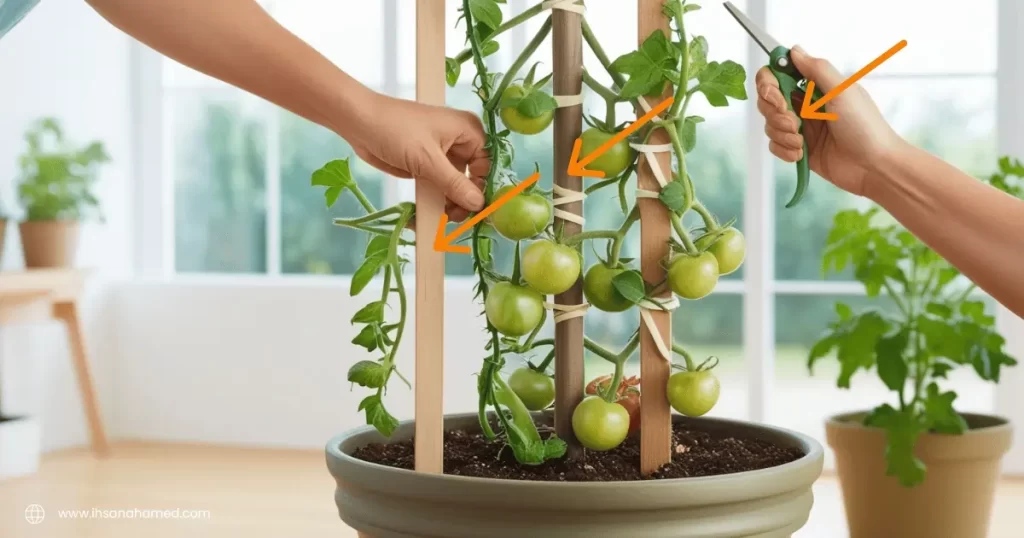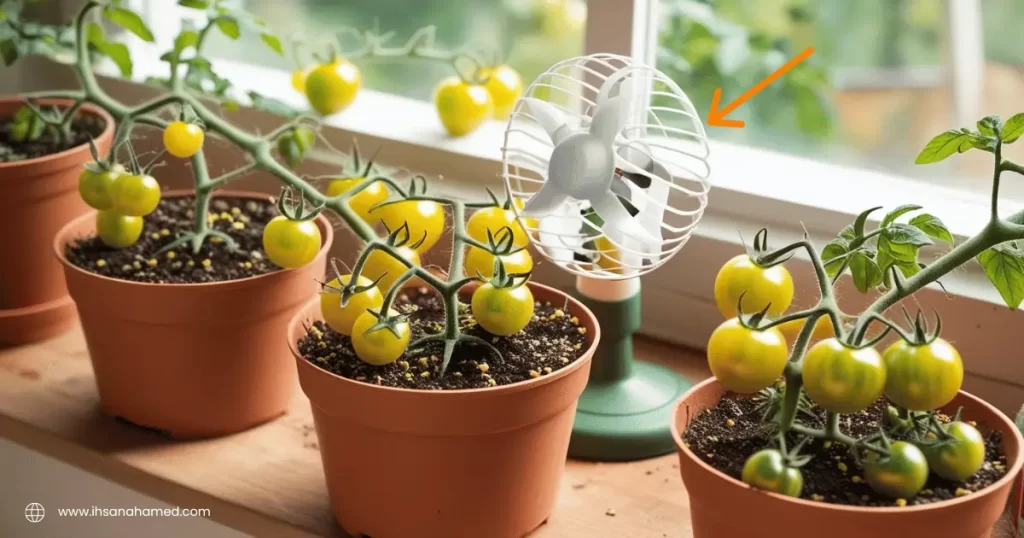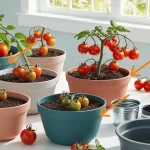1. How to Choose the Right varieties and growing tomatoes Indoors Containers?

Growing tomatoes in your home is joyous and happy because you will eat tomatoes whenever you want. For almost every dish we use tomatoes in our day-to-day life from salad to pizza.
Choosing the right tomatoes is crucial and it makes a difference among others. Here is a way how to choose the right tomatoes
Best Tomato Varieties for Indoors
When you are growing tomatoes in your home, it is important to choose a variety that is spacious and easy to manage. Here are the few best options to choose from.
Cherry Tomatoes: It’s a better choice and bite-sized tomatoes and it is perfect for indoors it is tiny and they don’t need a lot of space to grow. Think they are the superheroes for your home.
Patio Tomatoes: You can grow your juicy tomatoes and it’s perfect for balconies with tiny space in containers.
Dwarf Tomatoes: ‘Red Robin’ and ‘Tumbling Tom’ are the ninjas of the tomato world in tiny spaces and they are ready to deliver in small packages.
These varieties are growing in small and tiny spaces in your home with pots, containers, grow bags, and small indoor garden setups.
Determinate vs. Indeterminate Tomatoes
Tomatoes are mainly classified into two major types but you need to know the difference to decide what to grow indoors.
Determinate Tomatoes: These tomatoes have grown to a certain height and stopped growing. They produce all the tomatoes at once and it makes it easy to manage indoors. They don’t take much space and they are great for tiny spaces.
Indeterminate Tomatoes: These plants grow throughout the year without worrying about a season. They give juicy tomatoes on a periodic supply. They grow bigger and need more space and support.
If you want to grow bigger tomatoes and have a large space in your home, it’s a perfect choice for harvesting throughout the year.
Most indoor gardeners prefer determinate tomatoes because it’s simple and easy to grow in tiny spaces. But if you want continuous harvest throughout the year, you can prefer indeterminate varieties.
2. Container Basics for Growing Indoor Tomatoes

If you are planning and decided to grow tomatoes in your home, move to the next step with container choices and perfect soil mix.
Picking the Perfect Pot
Size Really Matters: Tomatoes need spaces to grow at their own pace and pots need at least 12-18 inches wide. Large pots can grow with more space from roots to spreads, it can help the plants to grow healthy.
Drainage: Always prefer a pot with drainage holes. These holes can help prevent water from pooling at the bottom. It can cause the roots to rot and your tomatoes may struggle if you don’t have proper drainage.
Choosing the Material: You can choose the material based on your choice. Some of them are plastics, clay pots, and fabric pots and these materials affect your plant growth.
- Plastic pots are weightless and retain moisture level
- Clay pots are a perfect design and let the soil breathe and dry out faster.
- Fabric is better in my personal experience they are breathable and help to avoid overwatering and it can avoid major damage to your plants
Soil Mix for Happy Tomatoes
Go for a Light and Airy Mix: Tomatoes need well-drained soil and it can hold the moisture level. Good mix soil such as peat moss and coco coir are perfect examples of light soil. Perlite and vermiculite help with good drainage. Add compost to the soil to give nutrient boosts.
Feed Them Well: Tomatoes need heavy feeders and rich soil to survive. Mix with compost or slow-release fertilizer for the right nutrients to them. In addition, you can give them worm castings and aged manure to give nitro boosts.
Check the pH: Check the pH level of the soil it must be between 6.0 to 6.8 and tomatoes need little acidic soil. You can check the soil with the best pH tester kit and it can be adjusted towards adding lime if the soil is less acidic and add sulfur if it is more acidic
Choose a perfect pot and soil mix to set a perfect stage for tomatoes to flourish in your home. If you follow the right strategy you can grow delicious tomatoes.
3. Light and Temperature: Essential Tips for Growing Indoor Tomatoes

If you want to grow tomatoes in your home, getting enough light and temperature is essential. Here is how you can keep your plants happy.
Sunlight vs. Grow Lights
Light is mandatory for growing tomatoes in indoor containers and you need natural sunlight use grow light to get enough light and it is crucial for successful growing in your home.
Sunlight: Tomatoes are sun lovers, it’s just like a human and it needs sun to survive. They need at least 6-8 hours of direct sunlight on a daily basis. If you have enough sunlight through windows preferably south-facing windows, then you can grow tomatoes to feel comfortable in your home.
If your home doesn’t have enough sunlight, no need to worry. You can grow a little bit slower or less production of tomatoes but they can still survive.
Grow Lights: You need a backup plan, natural sunlight is mandatory but you can have alternatives and you can have a little sun in your home.
LED grows are perfect for growing tomatoes and are energy efficient. Place the LED Light above the tomato plants for 12-18 inches and leave them for 12-16 hours a day for healthy growing my personal experience
Ideal Growing Temperatures
Daytime: Tomato plants love warm temperatures but don’t make them struggle by giving over warmth and maintaining between 70-85°F. Use a digital temperature to find out and maintain an ideal level.
I do personally by touching the leaves of the plant, if it is warm it is an ideal temperature level, if it feels cold or not warm it needs warmer and if it is hot, the temperature is too hot keep away from sunlight or give a break from grow light for at least 30 minutes to maintain an ideal temperature.
Nighttime: Tomatoes need a cool temperature at night preferably between 55-70°F. It needs sleep and rest time at night to be ready for the next day of growing. Keep them away from sudden temperature changes to make them sick.
Make sure tomatoes have enough light and track the right temperature with digital temperature and then chances to grow and enjoy fresh and homegrown tomatoes indoors throughout the year.
4. Watering and Feeding: Essential Tips for Indoor Tomatoes

Maintaining proper plant care is not just about light and warmth. But you need to master the water techniques for tomatoes to make a huge difference
Get Your Watering Routine Right
Watering indoor container vegetables, especially tomatoes may seem easy but it has to be done properly for healthy growing.
Keep It Consistent: Tomatoes need to thrive when the soil maintains the moisture level. If your soil dries quickly or is too wet it can cause problems such as cracker fruits, and yellow leaves.
When to Water: When you need to water your tomato plants depends upon plant size, type of soil, and indoor temperature. I stick my finger about an inch into the soil, if it is dry it’s time for watering. Or wait a little bit and try it again until you feel it is dry.
In warm homes, tomatoes may grow faster than usual, you need more watering often but consider my personal techniques at each time of watering.
Watering Technique: Watering at the base of the plants gives direct watering to roots and is needed almost often. Don’t make the leaves wet and it may cause fungal diseases if your home doesn’t have enough Air Circulation.
A slow, deep watering on the base works well and encourages the roots to grow deeper making a plant resilient and growing rapidly.
Feeding Your Tomatoes: The Right Way
Giving enough food is as important as watering. Tomato plants consume more water and they need plenty of rich nutrients to grow well and stronger.
It requires nitrogen for leaves, phosphorus for strong roots and flowers, and potassium for overall health and fruit quality.
When to Feed
Early Growth: Start giving a nutrient when tomatoes grow with few leaves. Use a balanced fertilizer using an NPK ratio of 10-10-10 mix (equal part of Nitrogen, phosphorus, and potassium) feed them for two weeks then grow stronger and healthier.
Flowering and Fruiting: When your tomatoes start to grow flowers then switch to a new technique fertilizer ratio of 5-10-10 (NPK) High in phosphorus and potassium and less Nitrogen.
Continue feeding them every couple of weeks to give tomatoes the nutrients and it can produce a lot of fruits.
Keep steady and routine watering techniques and feed them properly to give nutrients at the right time. You will keep them strong and healthy with proper maintenance and you can grow indoors to produce fresh and delicious fruits.
5. Support and Pruning: Simple Tips for Indoor Tomatoes

The next level of growing tomatoes needs support and pruning your indoor plants helps healthy and stronger. Here is how you can prune and support your indoor tomato plants.
Staking Indoor Tomatoes
Tomato plants can grow tall and heavy with fruits but need them to hold them up.
Use a Stake or Cage: When the Plant is young you can place a long stick stake or tomato cage in the pot and give the plant to lean on to grow
Tie the Plant: When your plant grows, tie the main stems to a stake cage or garden ties. This can keep the plants straight and prevent them from falling and easier for leaves from direct sunlight.
Pruning for Better Growth
The next level of growing technique is pruning which means cutting the weaker parts or some parts of the plants that need to be cut off for plant growth and health.
Remove Suckers: Find small shoots between main stems and branches and pinch them with your fingers. It can help the plant grow fruits instead of leaves.
Trim Lower Leaves: When plants start growing, trim off the leaves at the bottom of the plants to improve air circulation from major diseases. Right support and pruning regularly help them become stronger and produce more tasty tomatoes.
6. Managing Pests and Diseases: Keep Your Indoor Tomatoes Healthy

The next headache for growing tomatoes indoors containers is facing pests and diseases. You need to spot them and handle common indoor container problems.
Common Indoor Tomato Problems
Even indoor gardening can still face a few challenges while growing tomatoes indoors.
Aphids: The small pear-shaped insects in black, green, brown, yellow, and even pink, use their mouth for vital fluid that passes through the vascular system to weaken the plants and it is rich in nutrients.
It can cause some major damages like curl on leaves, yellow, and distortion. It is not easy to control them, they can easily reproduce and make the plant weak and make them die.
Powdery Mildew: It looks like a white powder on the leaven and weakens the plants from diseases and makes it difficult to recover.
Blossom End Rot: It may happen at the bottom of the fruits with dark and sunken spots and it happens due to calcium deficiency and imbalance in watering.
You need to keep a close watch on your plants from this disease before it becomes difficult to recover.
Natural Pest Control Methods
You can use the following natural method of recovery from fighting against the above pests and diseases.
Neem Oil: You can mix them in water and spray on the plants, it is effective against aphids and other small bugs.
Soap and Water Spray: The combination of water and dish soap helps prevent pests. Spray them gently in the affected areas only for recovery. Leaves can recover after a few hours.
Good Air Circulation: Make sure your plants have enough space around them and place good quality fans for better air circulation. It can avoid diseases like powdery and mildew.
You can use these natural methods to keep the pests and diseases away for plant growth and avoid using chemical treatments.
7. Pollination Tricks: Helping Your Indoor Tomatoes Thrive

Use pollination tricks to grow tomatoes at your home
When growing tomatoes indoors, you have to play the role of a pollinator and make sure there is no liquid substance to avoid bees buzzing around them. It can produce healthy and tasty tomatoes throughout the year.
Hand-Pollinating Indoor Tomatoes
Tomato flowers need a shake to move pollen from one to another and It is crucial for fruit growth.
Here are the steps on how to do it.
- Use a simple shake to move the pollen to another one
- Use a small paintbrush to collect and transfer from one flower to another.
- Brush them lightly inside a flower and dab on another flower
- Lightly tap the stems of the flowers with your fingers to prevent falling when required.
- Use these techniques repeatedly a few times a week for a chance to grow more tomatoes.
Using Fans for Pollination
Setting up a small fan near your tomatoes can help to feel a natural wind as close to them but outdoor tomatoes will get them naturally.
Make sure you are using the correct settings and make it low and gentle. High speed can stress and cause damage and major diseases.
Follow these simple tricks to grow tomatoes indoors to produce big, healthy, and juicy tomatoes without worrying about the seasons.
8. Harvesting Your Crop: Getting the Most from Your Indoor Tomatoes

Now we are in the happiness and enjoying stage, when and how to harvest your juice tomatoes to add freshness and flavor to your dishes and pizzas.
Here is a perfect time to pick up and store them properly with these essential tools for harvesting.
When to Pick Your Tomatoes
If your tomatoes turn into bright red( it may differ for different varieties). It’s the usual time to harvest and make sure there are no green spots.
Squeeze the tomatoes gently and it must feel slightly soft and it is a perfect stage for harvest. If you feel it is a little harder give some time for harvesting.
Ease of Picking: Vine with a gentle twist and motion of your hand is a method of harvesting ripe tomatoes and f not allowing them one or two days. That’s the right time for sweet and juicy tomatoes at your home.
Storing and Using Your Harvest
Once you pick tomatoes, it’s important to store them properly.
Room Temperature: Keep the freshly picked tomatoes from direct sunlight and keep it fresh at room temperature and it helps to maintain juice and flavor.
If your tomatoes are fully ripe and it is not ready to eat, you can keep them in the fridge and they may lose some flavor. You can eat once it comes to room temperature and enjoy the dishes.
Freshly harvested tomatoes in your room are good for salads, pizza, sandwiches and even you can eat as snacks.
If you have enough more, consider making sauces and keep them in a cooler for future uses like potato fries with tomato sauces, samosas with tomato sauces, spring rolls with sauces, and other snacks too, and enjoy fresh eating.
Conclusion
You gain an abundance of information about growing tomatoes indoors in container combos in your tiny homes or big flats, no matter what you can grow with perfect strategies for picking tomato varieties, lighting, temperature, watering, nutrients, maintenance, and harvesting.
I have covered a few other topics from starting indoor container gardens to vegetable container combos, Hydroponics vs Soil methods, and mastering the art of deep watering for containers.
Indoor gardening is a passion and enjoyable journey for me. I spend a lot of time learning all these techniques with test and trial methods. You need to experiment with what works for your spaces and it may vary for different plants and varieties. Every plant has a unique method to follow. You can always contact me for further guidance and support.
What are the best tomato varieties for indoor gardening?

The best tomato varieties for indoor gardening are those that are compact and manageable in smaller spaces. Some great options are cherry tomatoes, patio tomatoes, and dwarf tomatoes
What size container is best for growing tomatoes indoors?

A pot that’s at least 12-18 inches wide and deep is ideal for growing tomatoes indoors. This size provides enough room for the roots to spread, promoting healthier plant growth. Ensure the pot has drainage holes to prevent waterlogging.
How much light do indoor tomatoes need, and can I use grow lights?

Tomatoes need 6-8 hours of direct sunlight each day. If you don’t have enough natural sunlight, you can use LED grow lights. Keep the grow lights about 12-18 inches above the plants and use them for 12-16 hours a day to ensure the plants get enough light.
How often should I water indoor tomatoes, and what is the best watering technique?

Watering frequency depends on factors like plant size, soil type, and indoor temperature. Check the soil daily by using a digital thermometer or sticking your finger about an inch into it; water when it feels dry. Water at the base of the plant to direct moisture to the roots and avoid wetting the leaves to prevent fungal issues.
When is the best time to harvest indoor tomatoes, and how should I store them?

Harvest tomatoes when they are fully colored (usually bright red) and slightly soft to the touch. They should come off the vine easily with a slight twist. Store them at room temperature out of direct sunlight for the best flavor, or refrigerate if fully ripe Let refrigerated tomatoes return to room temperature before consuming to restore their flavor.







